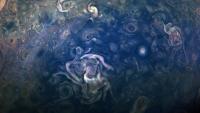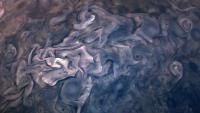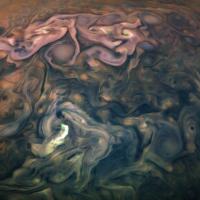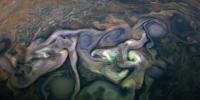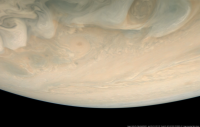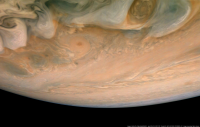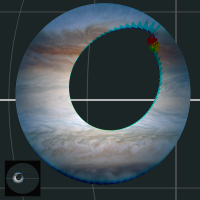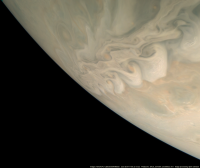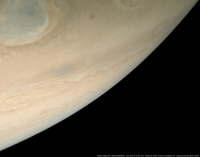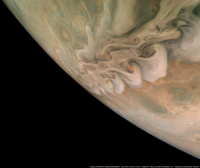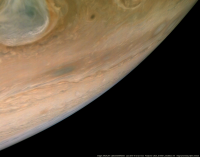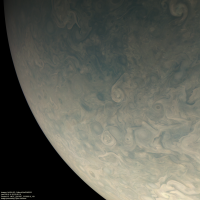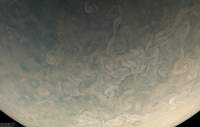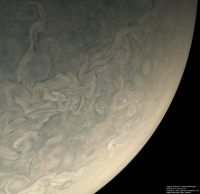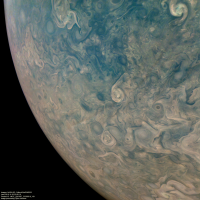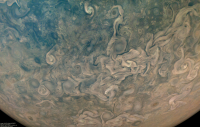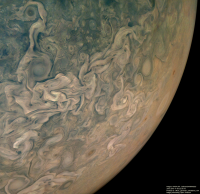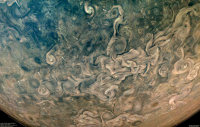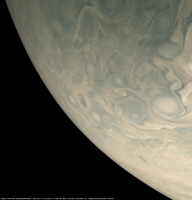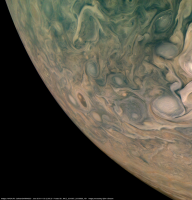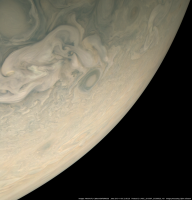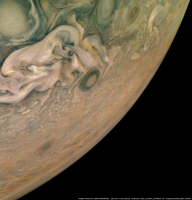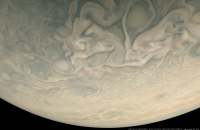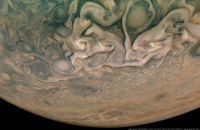Printable Version of Topic
Click here to view this topic in its original format
Unmanned Spaceflight.com _ Juno _ Juno Perijove 23
Posted by: Gerald Nov 7 2019, 03:42 AM
Some of the PJ23 data are already available.
I'll start with a JPG version of several selected "pretty pictures". Colors are a white-balanced in an arbitrary way. The images went through several post-processing steps.
#17, #18:
#19, #20:
Posted by: Gerald Nov 7 2019, 03:47 AM
#23, #24:
And #25:
I'll continue with less processed versions...
Posted by: Gerald Nov 7 2019, 04:10 AM
http://junocam.pictures/gerald/uploads/20191106/
http://junocam.pictures/gerald/uploads/20191106a/
http://junocam.pictures/gerald/uploads/20191106b/
http://junocam.pictures/gerald/uploads/20191106c/
http://junocam.pictures/gerald/uploads/20191106d/
The PNG version of the "pretty" images, and some of the reprojections with gamma=4 are uploaded to missionjuno (and approved).
Posted by: monitorlizard Nov 7 2019, 07:32 AM
Gerald, all I can say about the crop of image #22 (in post 2) is I see spots before my eyes and they're red and they're great! Nice job.
Posted by: Sean Nov 7 2019, 01:06 PM
Here is PJ23_21 from Gerald's source...
https://flic.kr/p/2hG5bjA
Posted by: Kevin Gill Nov 7 2019, 04:58 PM
Initial Perijove 23 composites:
https://flic.kr/p/2hG83wk
https://flic.kr/p/2hG83wk
https://flic.kr/p/2hGfEk8
https://flic.kr/p/2hGfEk8
Posted by: Kevin Gill Nov 7 2019, 05:02 PM
Views of Io on Perijove 23. On both, Jupiter and Io were processed separately. Jupiter is using a fisheye equisolid projection (less aggressively on the 2nd image). Io was processed directly from the raw image without using any reprojection. There was some Jupitershine visible on the dark side of Io and I attempted to respect that without allowing too much noise. I didn't notice any obvious volcanos.
https://flic.kr/p/2hGjKzQ
https://flic.kr/p/2hGjKzQ
https://flic.kr/p/2hGigdn
https://flic.kr/p/2hGigdn
Posted by: Bjorn Jonsson Nov 7 2019, 10:50 PM
Image PJ23_23 in an approximately true color/contrast and enhanced version:
Separate images showing areas farther to the left and right will follow later.
This is a very high resolution image, here Juno was only ~5200 km above Jupiter's cloud tops. The perijove latitude is now at latitude ~25 degrees north instead of closer to the equator as it was during the earlier orbits. The areas now imaged at the highest resolution are usually more spectacular visually than the fuzzier and more bland areas closer to the equator. As a result, lots of cloud shadows and other high contrast features are now imaged at very high resolution.
By the way I noticed that there has been some 'geometric' change at PJ23 that manifests itself as small gaps in the blue channel at the right edge of some of my processed images. This is different from all of the other orbits where the missing data at the right edge was red:
I'm not yet sure exactly what has changed but at least this isn't something that required any changes to my processing pipeline - everything still works perfectly.
Posted by: Brian Swift Nov 8 2019, 10:34 PM
PJ23_28
I'd wondered if sometime JunoCam would capture an annular footprint image.
Posted by: Bjorn Jonsson Nov 10 2019, 04:25 PM
Image PJ23_23, areas farther left/right than in the 'central' PJ23_23 image I posted earlier. Approximately true color/contrast and enhanced versions:
Posted by: Bjorn Jonsson Nov 20 2019, 11:50 PM
Image PJ23_18, approximately true color/contrast:
And with enhanced contrast/colors:
These images are interesting because of a very long haze band among other things. The band appears to cast a brownish shadow on the cloud deck below in the enhanced images. Below is an image where a stronger contrast stretch has been applied. The shadow is indicated with arrows; the haze band itself appears slightly brighter and bluer/whiter than the surrounding areas. Latitudes are planetographic and longitudes in system 3.
By the way I have noticed that for the PJ23 images I have needed to add a much smaller value to START_TIME than has been typical. I haven't processed a lot so far though (I have been concentrating on software development for increased automation and bigger accuracy when doing limb fits). It's possible that I've messed up which SPICE files I'm using although at first glance this didn't seem to be the case. The resulting images look perfectly normal despite this, i.e. good R/G/B alignment and nothing strange at the limb in map-projected images.
Posted by: mcaplinger Nov 21 2019, 01:10 AM
One thing I've found is that if possible you should wait for the reconstructed SPK files before trying to process, it has made a big difference for some orbits.
Posted by: Bjorn Jonsson Nov 25 2019, 09:18 PM
This is image PJ23_20 in approximately true color/contrast and enhanced versions:
The last image pair looks especially interesting. The enhanced image reveals pastel colors above and slightly left of center. The visual impression is that they seem to be associated with very bright clouds. These colors are a real feature and not a processing artifact. They are also visible in the true color/contrast version but look far more subdued there. The colors also appear in versions of image PJ23_20 processed by others, for example in Gerald's images. Hints of pastel colors have also been visible in some earlier JunoCam images (e.g. image PJ9_81) but they are particularly strong in this image.
For cosmetic purposes, a small gap on Jupiter's limb near the bottom in the last image pair was filled using data from image PJ23_21.
Posted by: Brian Swift Dec 3 2019, 09:11 PM
PJ23 flyover on YouTube https://youtu.be/e2zk4m2hvys
Posted by: Brian Swift Dec 9 2019, 07:08 PM
Mean and Stddev of my START_TIME adjustments for PJ23 are similar to other perijoves. (Using predict SPK since reconstructed isn't available yet).
Powered by Invision Power Board (http://www.invisionboard.com)
© Invision Power Services (http://www.invisionpower.com)
